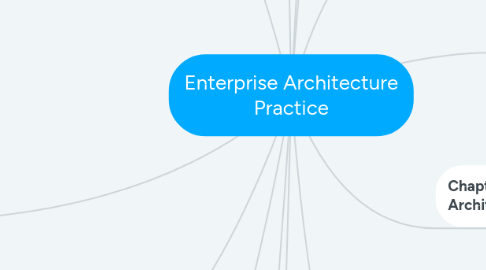
1. The Enterprise Architecture Approach s. 36
2. Chapter 1 An Overview of Enterprise Architecture
2.1. EA is a strategy and business-driven activity that supports management planning and decision-making by providing coordinated views of an entire enterprise
2.2. EA involves core elements, a management program, and a framework-based documentation method.
2.3. Keywords
2.3.1. six core elements
2.3.1.1. Governance
2.3.1.2. Methodology
2.3.1.3. Framework
2.3.1.3.1. EA3 Cube Framework
2.3.1.4. Artifacts
2.3.1.5. Standards
2.3.1.6. Best Practices
2.3.2. Enterprise
2.3.3. Enterprise Architecture
2.3.4. Enterprise Architecture = Strategy + Business + Technology
2.3.4.1. Linking Strategy, Business, and Technology: EA is most effective when it simultaneously supports top-down executive planning and decision-making across the enterprise and bottom-up management planning and decision-making within each LOB
2.3.5. Line of Business (LOB)
2.3.6. Architecture Segment
2.3.7. Vertical Component
2.3.8. Horizontal (Crosscutting) Component
2.4. Summary
2.4.1. Summary: A program or systems-level perspective is not sufficient for the management and planning of technology and other resources across enterprises with significant size and complexity. EA is the one discipline that looks at systems holistically as well as provides a strategy and business context. EA was described as being as both a management process and an analysis and design method that helps enterprises with business and technology planning, resource management, and decision-making. The purposes of an EA management program were described: strategic alignment, standardized policy, decision support, and resource development. The six basic elements of an EA analysis and design method were presented: the EA documentation framework, EA components, current EA views, future EA views, an EA Management Plan and multilevel threads that include security, standards, and workforce planning. An example of how to communicate the various areas of an EA framework was also provided. The following chapters of Section I will describe why EA is valuable to many types of enterprises, what the risks of doing EA are, and how to ensure that an architecture is driven by strategic goals and business requirements.
3. Chapter 2 The Structure and Culture of Enterprises
3.1. Keywords
3.1.1. Culture
3.1.2. Stakeholder
3.1.3. Change Management
3.1.3.1. The process of setting expectations and involving stakeholders in how a process or activity will be changed, so that the stakeholders have some control over the change and therefore may be more accepting of the change.
3.2. Summary
3.2.1. This chapter described how enterprises are types of social organizations and discussed the importance of understanding the structure and culture of the enterprise that an EA is documenting. While it is also important to understand the enterprise's processes and supporting technologies, it is the people of the enterprise who make plans and decisions about strategic direction, business activities, and resource utilization. The chapter also covered influences on the field of EA and presented two models of organizations and enterprises that can assist in the development of current and future EA views. Finally, the importance of managing change was discussed in that EA program activities may be resisted by stakeholders who feel a loss of input or control
3.3. Understanding culture and Managing change in a company - John Kotter.
3.3.1. EA is a new way of conduction business and the processes in the company. Therefore imfortant to keep and eye on the emploies and stakeholders related to how they react to change.
3.3.2. Involving stakeholders in the EA program's establishment and management. Regularly and effectively communicating EA activities to stakeholders. Allowing for stakeholder input to EA planning and decision-making. Managing stakeholder expectations as to what the EA program can do.
4. Chapter 3 The Value and Risk of Creating an Enterprise Architecture
4.1. Summary
4.1.1. This chapter provided a detailed discussion of the value and risk of establishing an EA program. A clear articulation of the business case for EA is needed to obtain executive sponsorship and resources for EA program implementation and maintenance. Quantifying the areas of value that the EA program will contribute is important, and those include improved communication, planning, and decision-making. A total lifecycle approach to estimating costs is used to differentiate the one-time direct and indirect costs associated with program start-up and initial EA documentation from the ongoing costs of EA program management and documentation updates. Comparisons were made in the area of EA labor costs between in-house salaries and the expense of paying for external EA consulting support. In concluding the discussion of EA value, the linkage between EA, strategy, business, and technology was shown.
4.2. Value. s.73
4.2.1. Shortening Planning Cycles
4.2.1.1. by providing a robust repository of on-line information regarding current and future processes and resources
4.2.2. More Effective Planning Meetings
4.2.3. Shorter Decision-Making Cycles
4.2.4. Improved Reference Information
4.3. Risk
4.3.1. Risk is related to uncertainty
4.3.2. Financial
4.3.3. Lack of Acceptance
4.3.4. Loss of Key Personnel
4.3.5. Mitigating Risk
4.3.5.1. Risk identification and mitigation
5. Chapter 4 The Implementation Methodology
5.1. Stovepipe
6. Chapter 5 The Analysis and Documentation Framework
7. Section II Developing an Enterprise Architecture
8. perso
9. EA Cube 3
10. Enterprise Architure. =
10.1. Strategy
10.1.1. Planning for primary driver of the enterprise
10.2. Business
10.2.1. Planning programs and resource requirements
10.3. Technology
10.3.1. Planning, design systems, applications, networks, call centers, networks
